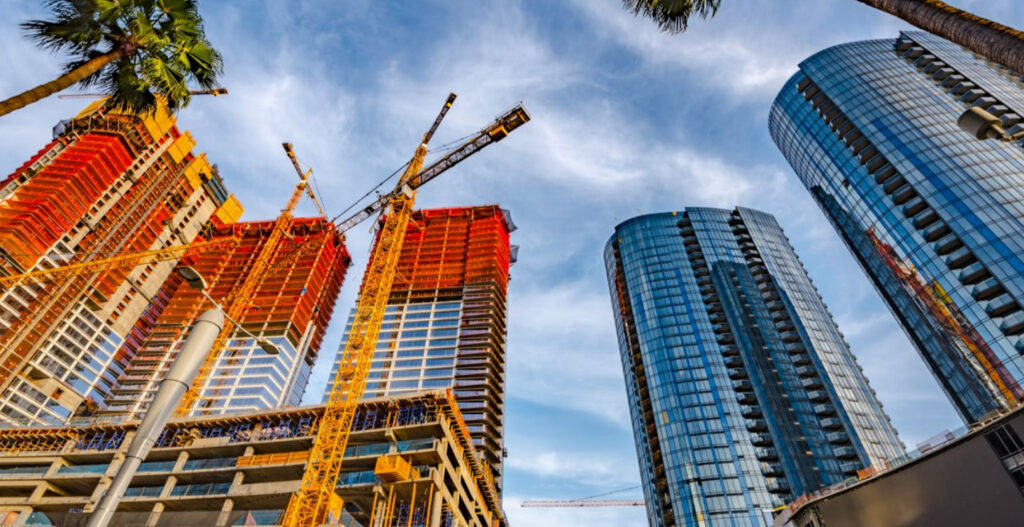More than half of the world's population lives in citieswhere more than 78% of the global energy and the 70% are generated from the carbon emissions. The built environment, which encompasses both the construction emissions, such as building and infrastructure operations, account for approximately 40% of total emissions.
The challenge for cities, as they expand, is to accommodate growth while reducing the amount of greenhouse gas (GHG) emissions related to both construction and demolition, known as embedded carbon.
The report Embodied carbon reduction in cities: nine solutions for greener buildings and communitiesin which the following collaborate World Economic Forum y Accenturehighlights actions that are already working in some cities, which can be adapted and replicated in other communities, to accelerate innovation across the entire region. construction industry.

Adoption of enabling policy and regulatory frameworks
The first three solutions are focused on the establishment of regulatory frameworks y sound policies that encourage and require low-carbon practices. They may include the need to create guidelines and standards to encourage the adoption of sustainable technologies and practices in urban environments, the paper notes.
1. Requirements for low-carbon materials
The embedded carbon in buildings comes mainly from materials such as cementwhich is the main contributor to emissions due to its intensive use in the production of concrete. To reduce these emissions, it is necessary to decarbonize construction through the use of materials of the highest quality low carbon emission.
"Low-carbon concrete, an environmentally friendly alternative to conventional concrete, achieves a significantly reduced carbon footprint through a strategic substitution: it replaces part of the cement with supplementary cementitious materials (SCMs), such as fly ash, slag or calcined clays that offer similar or even superior properties to cement," the report states.
This alternative can reduce emissions by up to 70% and contribute to waste management by reusing discarded materials. However, the effectiveness of this reduction depends on factors such as the availability of materials and transparency in the measurement of emissions.
2. Terms of Reference for Lifetime Carbon Assessments
Traditional systems for measuring emissions in construction often ignore the embedded carbon emissions in materials and processes, which account for approximately 50% of a building's lifetime emissions. To reduce the environmental impactIn addition, it is crucial to measure and report all emissions from the construction phase to the end of the building's useful life.
One example is the strategy of Vancouverwhich implements Whole Building Life Cycle Assessments (WBLCA) and standardized methodologies to promote sustainable and low-carbon practices in construction.
3. Clean Construction Executive Orders
The challenge of addressing the embedded carbon in urban development requires comprehensive action in both public and private sector projects. The public sector, being one of the largest developers and operators of real estate and infrastructure, has the opportunity to lead the emissions reduction through its own operations and to establish guidelines for future policies.
The solution lies in the development of an executive order focused on the clean constructionto enable the municipalities to significantly reduce the embedded carbon in their construction practices. This order can also influence public procurement policies by promoting the procurement of electric construction equipment and encouraging sustainable practices, incentivizing the market to adopt greener solutions.

Ecosystem enhancement with low embodied carbon emissions
The following three solutions emphasize building an infrastructure and supporting ecosystem that generates, promotes and rewards the implementation of low carbon solutions. This involves promoting collaboration between stakeholders, investing in green infrastructure and develop sustainable models for energy, transportation and waste management.
4. Large-scale adaptive reuse
A historical problem in the urban development is the sustainable use of existing infrastructure in the face of increasing demand for new construction. Rapid urbanization often favors the creation of new buildings, which increases the carbon emissionsThe urbanization of the city is a major source of waste, waste generation and the depletion of natural resources. To address this, it is crucial to rethink urban development practices and focus on reusing and adapting existing structures rather than discarding them.
The adaptive reuse large-scale reduction of the carbon emissions by making existing buildings and materials part of the climate solution. This reduces CO2 emissions associated with new materials and reduces waste.
Strategies such as reuse, product reduction and recycling, use of local materials, design for disassembly, and building remodeling can be implemented. Policies that encourage the adaptive reuse through incentives and the relaxation of regulations are essential to make it viable, overcoming cost barriers and regulatory restrictions.
5. Citywide circular economy strategy
Cities face multiple challenges due to the linear model of consumption and production, which generates large amounts of waste, depletes finite resources and contributes to environmental degradation. This model also causes social and economic problems, such as unequal access to resources and economic instability.
To address these problems, it is proposed to adopt a circular economy strategy at the urban level to minimize waste, maximize resource efficiency and promote sustainable economic development. The circular economy is based on eliminating waste, maintaining products and materials in use, and regenerating natural systems, contributing to the creation of sustainable urban ecosystems.
6. Electrification programs for heavy transport and machinery.
The use of heavy vehicles that rely on fossil fuels generates a carbon footprint significant in the cities, contributing to the embedded carbon in the built environment. This is due to the transport of raw materials, construction materials and the operation of heavy machinery. Transport dependence on conventional fuels also worsens pollution and affects public health, especially in a context of rapid urbanization and urban sprawl.
In order to reduce this impact, it is proposed to accelerate the adoption of electric fleets y decarbonize heavy transport and construction machinery. This requires financial incentive programs and subsidies, as well as collaboration between public service providers, government agencies and private industry. In addition, it is critical to develop robust infrastructure for electric vehicles and advance battery technology for heavy-duty vehicles, which will facilitate the transition to more sustainable, zero-emission transportation practices.

Boosting innovation
The last three solutions put forward by the World Economic Forum and Accenture focus on boosting the technological advances and the innovation in various sectors to mitigate the embedded carbonreduce the carbon footprint in all industries and urban landscapes.
7. Innovation Center for Clean Construction
The problem of embedded carbon in construction is complex and difficult to measure, requiring the collaboration of multiple actors across the value chain, both from the public and private sectors. To address this challenge, it is necessary to develop new approaches and strategies to bring scalable solutions to the market.
The innovation centers play a crucial role in this process, bringing together researchers, creators and innovators to develop products and services that transform the industry.
Adapted to the construction with low carbon emissionsThese centers can foster research and development of new materials and methods, facilitate collaboration between different sectors and institutions, and promote the development of new materials and methods. sustainable practicesThey also serve as physical or virtual spaces that promote the innovation and the sustainability in the construction industry.
8. Residential deconstruction and workforce development programs.
The increase in new building construction and the aging of existing structures present both a challenge and an opportunity for more sustainable development. Indiscriminate demolition generates large quantities of waste and wastes valuable materials, while the demand for circular and sustainable building practices requires a workforce trained in innovative solutions. However, traditional workforce training often does not align with these needs.
One solution is for governments to promote the deconstruction instead of demolition, a process that allows buildings to be systematically dismantled to recover and reuse materials. This practice not only reduces waste and maximizes recycling, but also generates more jobs compared to landfills. This approach is ideal for cities with older buildings and a growing demand for new construction, facilitating the transition to a more efficient and sustainable use of materials. greener and circular economy.
9. Online marketplace for a circular environment in construction
The built environment is responsible for high resource consumption and significant waste generation and CO2 emissions. In particular, the interior fit-out of buildings contributes significantly to these emissions and waste generation. However, the use of recycled materials and awareness of reuse are still limited.
To address this problem, a online reuse marketplace based on a centralized platform can facilitate access to recycled and reused materials. This platform unifies material listings, improving transparency and the availability of data on the supply and demand of these materials.
Adopting a comprehensive approach
The report of World Economic Forum y Accenture stresses that cities should prioritize the reduction of embodied carbon emissions in its urban agendas to improve public health, long-term sustainability and urban vitality, but to achieve this, collaborative funding models and diverse resources to facilitate the implementation of critical initiatives are essential.
However, he stresses that solutions must go beyond mere carbon reduction and adopt a more integrated approach. integrated approach including social and economic benefits, workforce development and strengthening the local economy.
It is essential that these solutions are tailored to the specific needs of each city and are applicable at different scales. Collaboration between cities, businesses and communities is essential to foster innovation, allocate resources effectively and take concrete actions towards a more sustainable future.
Source: World Economic Forum


